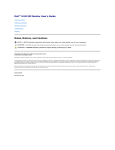Download Dell E1709W User's Manual
Transcript
Dell™ E1709W Flat Panel Monitor User's Guide About Your Monitor Setting Up the Monitor Operating the Monitor Troubleshooting Appendix Notes, Notices, and Cautions NOTE: A NOTE indicates important information that helps you make better use of your computer. NOTICE: A NOTICE indicates either potential damage to hardware or loss of data and tells you how to avoid the problem. CAUTION: A CAUTION indicates a potential for property damage, personal injury, or death. Information in this document is subject to change without notice. © 2008 Dell Inc. All rights reserved. Reproduction of these materials in any manner whatsoever without the written permission of Dell Inc. is strictly forbidden. Trademarks used in this text: Dell and the DELL logo are trademarks of Dell Inc; Microsoft a n d Windows are either trademarks or registered trademarks of Microsoft Corporation in the United States and/or other countries; Adobe is a trademark of Adobe Systems Incorporated, which may be registered in certain jurisdictions. ENERGY STAR is a registered trademark of the U.S. Environmental Protection Agency. As an ENERGY STAR partner, Dell Inc. has determined that this product meets the ENERGY STAR guidelines for energy efficiency. Other trademarks and trade names may be used in this document to refer to either the entities claiming the marks and names or their products. Dell Inc. disclaims any proprietary interest in trademarks and trade names other than its own. Model E1709Wc July 2008 Rev. A00 Back to Contents Page About Your Monitor Dell™ E1709W Flat Panel Monitor User's Guide Package Contents Product Features Identifying Parts and Controls Monitor Specifications Plug and Play Capability LCD Monitor Quality & Pixel Policy Maintenance Guidelines Package Contents Your monitor ships with all the components shown below. Ensure that you have received all the components and Contact Dell™ if anything is missing. NOTE: Some items may be optional and may not ship with your monitor. Some features or media may not be available in certain countries. l Monitor l Stand l Power Cable l VGA Cable (attached to the monitor) l Drivers and Documentation media Quick Setup Guide Safety Information l l Product Features The Dell™ E1709W flat panel display has an active matrix, thin-film transistor (TFT), liquid crystal display (LCD). The monitors features include: ■ Dell E1709W has a 17-inch (433.0 mm) viewable area display. ■ 1440x900 resolution, plus full-screen support for lower resolutions. ■ Wide viewing angle to allow viewing from a sitting or standing position, or while moving from side-to-side. ■ Tilt capability. ■ Removable pedestal and Video Electronics Standards Association (VESA) 100mm mounting holes for flexible mounting solutions. ■ Plug and play capability if supported by your system. ■ On-Screen Display (OSD) adjustments for ease of set-up and screen optimization. ■ Software and documentation media which includes an information file (INF), Image color Matching File (ICM), and product documentation. ■ Energy Saver feature for ENERGY STAR® compliance. ■ Security lock slot. Identifying Parts and Controls Front view 1. OSD menu button 2. Brightness and Contrast/Up button 3. Auto adjust/Down button 4. Enter button 5. Power On/Off button (with LED indicator) Back View Label Description Use 1 Barcode serial number label Refer to this label if you need to contact Dell for technical support. 2 Regulatory rating label List the regulatory approvals. 3 VESA mounting holes (100mm) To mount the monitor. 4 Security lock slot Use a security lock with the slot to help secure your monitor. Side View Left side Right side Bottom View Label Description Use 1 AC power connector To connect the monitor power cable. 2 VGA connector To connect your computer to the monitor using a VGA cable. Monitor Specifications The following sections give you information about the various power management modes and pin assignments for the various connectors of your monitor. Power Management Modes If you have VESA's DPM compliance display card or software installed in your PC, the monitor automatically reduces its power consumption when not in use. This is referred to as Power Save Mode. If the computer detects input from keyboard, mouse, or other input devices, the monitor automatically resumes functioning. The following table shows the power consumption and signaling of this automatic power saving feature: VESA Modes Horizontal Sync Vertical Sync Video Power Indicator Power Consumption Normal operation Active Active Active Blue 20(normal) /25w (maximum) Active-off mode Inactive Inactive Blank Amber Less than 2 W Switch off - - - Off Less than 1 W The OSD will only function in the normal operation mode. When any button except power button is pressed in Active-off mode, the following messages will be displayed: Activate the computer and monitor to gain access to the OSD. NOTE: Dell E1709W Flat Panel monitor is TC099 and ENERGY STAR®-compliant. Zero power consumption in OFF mode can only be achieved by disconnecting the main cable from the monitor. Pin Assignments 15-pin D-Sub connector Pin Number Monitor Side of the 15-pin Side Signal Cable 1 Video-Red 2 Video-Green 3 Video-Blue 4 GND 5 Self-test 6 GND-R 7 GND-G 8 GND-B 9 DDC +5V 10 GND-sync 11 GND 12 DDC data 13 H-sync 14 V-sync 15 DDC clock Plug and Play Capability You can install the monitor in any Plug and Play-compatible system. The monitor automatically provides the computer with its Extended Display Identification Data (EDID) using Display Data Channel (DDC) protocols so that the system can configure itself and optimize the monitor settings. Most monitor installations are automatic. You can select different settings if required. Flat Panel Specifications Model number Dell E1709W Flat Panel Monitor Screen type Active matrix - TFT LCD Panel Type TN Screen dimensions 17 inches (17-inch wide viewable image size) Preset display area: l Horizontal 367.2mm (14.5 inches) l Vertical 229.5mm (9.04 inches) Pixel pitch 0.255mm Viewing angle: l Horizontal 160° typical l Vertical 150° typical Luminance output 250 CD/m ²(typical) Contrast ratio 600 to 1 (typical) Faceplate coating Anti-glare Backlight CCFL edgelight system Response Time 8ms typical Color Gamut 65% (typical)* *Dell E1709W Flat Panel monitor color gamut (typical) is based on CIE 1976 (65%) and CIE1931 (60%) test standards. Resolution Specifications Model number Dell E1709W Flat Panel Monitor Scan range l Horizontal 30 kHz to 83 kHz (automatic) l Vertical 56 Hz to 75 Hz (automatic) Optimal preset resolution 1440 x 900 at 60 Hz Highest preset resolution 1440 x 900 at 60 Hz Electrical Specifications Model number Dell E1709W Flat Panel Monitor Video input signals Analog RGB: 0.7 Volts +/-5%, 75 ohm input impedance Synchronization input signals Separate horizontal and vertical synchronizations, polarity-free TTL level, SOG (Composite SYNC on green) AC input voltage / frequency / current 100 to 240 VAC/50 or 60 Hz + 3 Hz/1.6A (Max.) Inrush current 120V:30A (Max.) 240V:60A (Max.) Preset Display Modes The following table lists the preset modes for which Dell guarantees image size and centering: Display Mode Horizontal Frequency (kHz) Vertical Frequency (Hz) Pixel Clock (MHz) Sync Polarity (Horizontal/Vertical) VESA, 720 x 400 31.5 70.0 28.3 -/+ VESA, 640 x 480 31.5 60.0 25.2 -/- VESA, 640 x 480 37.5 75.0 31.5 -/- VESA, 800 x 600 37.9 60.3 40.0 +/+ VESA, 800 x 600 46.9 75.0 49.5 +/+ VESA, 1024 x 768 48.4 60.0 65.0 -/- VESA, 1024 x 768 60.0 75.0 78.8 +/+ VESA, 1152 x 864 67.5 75.0 108.0 +/+ VESA, 1280 x 1024 64.0 60.0 108.0 +/+ VESA, 1280 x 1024 80.0 75.0 135.0 +/+ 55.935 60.0 106.5 -/+ VESA, 1440 x 900 Physical Characteristics The following table lists the monitor physical characteristics: Model Number Dell E1709W Flat Panel Monitor Connector type 15-pin D-subminiature, blue connector; Signal cable type Analog: Detachable, D-Sub, 15pins, shipped attached to the monitor Dimensions: (with stand) l Height 13.17 inches ( 334.58 mm) l Width 15.91 inches ( 404.15 mm) l Depth 6.17 inches ( 156.72 mm) Dimensions: (without stand) l Height 10.49 inches ( 266.45 mm) l Width 15.91 inches ( 404.15 mm) l Depth 2.17 inches ( 55.0 mm) Stand dimensions: l Height 4.20 inches ( 106.8 mm) l Width 8.66 inches ( 219.92 mm) l Depth 6.17 inches ( 156.72 mm) Weight with packaging 9.5 lbs (4.32 kg) Weight with stand assembly and cables 7.43 lbs ( 3.37 kg) Weight without stand assembly (For wall mount or VESA mount considerations - no cables) 5.81 lbs ( 2.64 kg) Weight of stand assembly 0.83 lbs ( 0.38 kg) Environmental Characteristics The following table lists the environmental conditions for your monitor: Model Number Dell E1709W Flat Panel Monitor Temperature l Operating 0° to 40°C (32° to 104°F) l Non-operating Storage: -20° to 60°C (-4° to 140°F) Shipping: -20° to 60°C(-4° to 140°F) Humidity l Operating 10% to 80% (non-condensing) l Non-operating Storage: 5% to 90% (non-condensing) Shipping: 5% to 90%(non-condensing) Altitude l Operating 3,657.6m (12,000 ft) max l Non-operating 12,192m (40,000 ft) max Thermal dissipation 256.08 BTU/hour (maximum) 119.5 BTU/hour (typical) LCD Monitor Quality & Pixel Policy During the LCD Monitor manufacturing process, it is not uncommon for one or more pixels to become fixed in an unchanging state. The visible result is a fixed pixel that appears as an extremely tiny dark or bright discolored spot.When the pixel remains permanently lit, it is known as a “bright dot.” When the pixel remains black, it is known as a “dark dot.” In almost every case, these fixed pixels are hard to see and do not detract from display quality or usability. A display with 1 to 5 fixed pixels is considered normal and within competitive standards. For more information, see Dell Support site at: support.dell.com. Maintenance Guidelines Caring for your Monitor CAUTION: Read and follow the safety instructions before cleaning the monitor. CAUTION: Before cleaning the monitor, unplug the monitor power cable from the electrical outlet. For best practices, follow the instructions in the list below while unpacking, cleaning, or handling your monitor: l l l l l To clean your antistatic screen, slightly dampen a soft, clean cloth with water. If possible, use a special screen-cleaning tissue or solution suitable for the antistatic coating. Do not use benzene, thinner, ammonia, abrasive cleaners, or compressed air. Use a slightly dampened, warm cloth to clean the plastics. Avoid using detergent of any kind as some detergents leave a milky film on the plastics. If you notice a white powder when you unpack your monitor, wipe it off with a cloth. This white powder occurs during the shipping of the monitor. Handle your monitor with care as a darker-colored monitor may scratch and show white scuff marks more than a lighter-colored monitor. To help maintain the best image quality on your monitor, use a dynamically changing screen saver and power off your monitor when not in use. Back to Contents Page Back to Contents Page Appendix Dell™ E1709W Flat Panel Monitor User's Guide Safety Instructions FCC Notice (U.S. Only) and Other Regulatory Information Contacting Dell CAUTION: Safety Instructions CAUTION: Use of controls, adjustments, or procedures other than those specified in this documentation may result in exposure to shock, electrical hazards, and/or mechanical hazards. For information on safety instructions, see the Product Information Guide. FCC Notices (U.S. Only) and Other Regulatory Information For FCC notices and other regulatory information, see the regulatory compliance website located at www.dell.com\regulatory_compliance. Contacting Dell For customers in the United States, call 800-WWW-DELL (800-999-3355). NOTE: If you do not have an active Internet connection, you can find contact information on your purchase invoice, packing slip, bill, or Dell product catalog. Dell provides several online and telephone-based support and service options. Availability varies by country and product, and some services may not be available in your area. To contact Dell for sales, technical support, or customer service issues: 1. Visit support.dell.com. 2. Verify your country or region in the Choose A Country/Region drop-down menu at the bottom of the page. 3. Click Contact Us on the left side of the page. 4. Select the appropriate service or support link based on your need. 5. Choose the method of contacting Dell that is convenient for you. Back to Contents Page Back to Contents Page Setting Up Your Monitor Dell™ E1709W Flat Panel Monitor If you have a Dell™ desktop or a Dell™ portable computer with internet access 1. Go to http://support.dell.com, enter your service tag, and download the latest driver for your graphics card. 2. After installing the drivers for your Graphics Adapter, attempt to set the resolution to 1440x900 again. NOTE: If you are unable to set the resolution to 1440x900, please contact Dell™ to inquire about a Graphics Adapter that supports these resolutions. Back to Contents Page Back to Contents Page Setting Up Your Monitor Dell™ E1709W Flat Panel Monitor If you have a non Dell™ desktop, portable computer, or graphics card 1. Right-click on the desktop and click Properties. 2. Select the Settings tab. 3. Select Advanced. 4. Identify your graphics controller supplier from the description at the top of the window (e.g. NVIDIA, ATI, Intel etc.). 5. Refer to the graphic card provider website for updated driver (for example, http://www.ATI.com OR http://www.NVIDIA.com ). 6. After installing the drivers for your Graphics Adapter, attempt to set the resolution to 1440X900 again. NOTE: If you are unable to set the resolution to 1440x900, please contact the manufacturer of your computer or consider purchasing a graphics adapter that will support the video resolution of 1440x900. Back to Contents Page Back to Contents Page Operating the Monitor Dell™ E1709W Flat Panel Monitor User's Guide Using the Front Panel Controls Using the On-Screen Display (OSD) Menu Setting the Optimal Resolution Using the Tilt Using the Front Panel Use the control buttons on the front of the monitor to adjust the characteristics of the image being displayed. As you use these buttons to adjust the controls, an OSD shows the numeric values of the characteristics as they change. Front panel Button A Description Use the MENU button to launch the on-screen display (OSD) and select the OSD Menu. See Accessing the Menu System. Menu B Use this button to directly access the "Brightness/Contrast" menu or to increase the values of the selected menu option. Brightness&Contrast /Adjust UP C Use Auto Adjust to activate automatic setup/adjustment or to decrease the values of the selected menu option. The following dialog appears on a black screen as the monitor self-adjusts to the current input: Automatic Adjust /Adjust Down Auto Adjustment allows the monitor to self-adjust to the incoming video signal. After using Auto Adjustment, you can further tune your monitor by using the Pixel Clock (Coarse) and Phase (Fine) controls under Image Settings. NOTE: Auto Adjust does not occur if you press the button while there are no active video input signals or attached cables. D Use this button to select an OSD menu option. If VGA cable is not connected, a floating dialog box as shown below appears. Select Use the Power button to turn the monitor on and off. E The Blue LED indicates the monitor is on and fully functional. An amber LED indicates DPMS power save mode. Power (with power light indicator) Using the On-Screen Display (OSD) Menu Accessing the Menu System NOTE: If you change the settings and then either proceed to another menu or exit the OSD menu, the monitor automatically saves those changes. The changes are also saved if you change the settings and then wait for the OSD menu to disappear. 1.Push the MENU button to launch the OSD menu and display the main menu. 2. Push the and buttons to move between the setting options. As you move from one icon to another, the option name is highlighted. See the following table for a complete list of all the options available for the monitor. 3. Push the 4. Push button once to activate the highlighted option. and 5. Push button to select the desired parameter. to enter the slide bar and then use the and buttons, according to the indicators on the menu, to make your changes. 6. Select the "Menu/Exit" option to return to the main menu or exit the OSD menu. Icon Menu and Submenus BRIGHTNESS & CONTRAST Description Use this menu to activate Brightness/Contrast adjustment. Brightness Brightness adjusts the luminance of the backlight. Push the Contrast button to increase brightness and push the button to decrease brightness (min 0 ~ max 100). Adjust Brightness first, and then adjust Contrast only if further adjustment is necessary. Push the button to increase contrast and push the button to decrease contrast (min 0 ~ max 100). The Contrast function adjusts the degree of difference between darkness and lightness on the monitor screen. AUTO ADJUST Even though your computer recognizes your monitor on startup, the Auto Adjustment function optimizes the display settings for use with your particular setup. NOTE: In most cases, Auto Adjust produces the best image for your configuration. COLOR SETTINGS Use the Color Settings to adjust the color setting mode and color temperature. There are different color setting sub-menus for VGA and Video input. Input Color Format Choose the RGB option if monitor is connected to a PC or a DVD using a VGA cable. Choose the YPbPr option if monitor is connected to a DVD by a YPbPr to VGA or if the DVD color output setting is not RGB. Mode Selection You can choose Graphics or Video according to the input signal. Select Graphics if connecting a PC to your monitor; for connecting DVD, STB or VCR to your monitor, Video is recommended. Preset Modes When you select Graphics, you can choose Standard, Multimedia, Game, Warm, Cool, or Custom (RGB); l l l l l l l l l If you view media application like photo, clip etc via PC, choose "Multimedia" preset; If you play a game in PC, choose "Gaming" preset; If you prefer a lower color temperature (5700K), choose "Warm" preset; If you prefer a higher color temperature, choose "Cool" preset; Custom (RGB) Preset offers a range of 6500K colors; Choose "Standard" to utilize the panel native color format; Select Warm preset for a reddish tint. This color setting is used for color-intensive applications (photograph image editing, multimedia, movies, etc.) Select Cool preset for a bluish tint. This color setting is used for text based applications (spreadsheets, programming, text editors, etc.) Select Custom preset to increase or decrease each of the three colors (RGB) independently, in single digit increments, from 0 to 100. When you select Video, you can choose Movie, Game, Sports, or Nature preset: l l l l l For playing a movie, choose "Movie" preset; For playing a sport program, choose "Sports" preset; For playing a game, choose "Game" preset; For general picture or web or watch TV, choose Nature preset. You can adjust the Hue(Tint)/Saturation based on your preference. Select Reset Color Settings to restore default (factory) Color settings. Hue This feature can shift color of video image to green or purple. This is used to adjust the desired flesh tone color. Use or to adjust the hue from '0' to '100' . Push to increase the green shade of the video image Push to decrease the purple shade of the video image NOTE: Hue adjustment is available only for video input. Saturation This feature can adjust the color saturation of the video image. Use '100'. Push to increase the monochrome appearance of the video image Push to decrease the colorful appearance of the video image NOTE: Saturation adjustment is available only for video input. Reset Color Settin gs Reset your monitor color settings to the factory settings. DISPLAY SETTINGS Use the Display Settings to adjust image. or to adjust the saturation from '0' to Horizontal Position Vertical Position Sharpness Pixel Clock Use the or buttons to adjust image left and right. Minimum is '0' (-). Maximum is '100' (+). Use the or buttons to adjust image up and down. Minimum is '0' (-). Maximum is '100' (+). This feature can make the image look sharper or softer. Use or to adjust the sharpness from '0' to '100'. The Phase and Pixel Clock adjustments allow you to adjust your monitor to your preference. These settings are accessed through the main OSD menu, by selecting 'Image Settings'. Use the or buttons to adjust for best image quality. Phase If satisfactory results are not obtained using the Phase adjustment, use the Pixel Clock (coarse) adjustment and then use Phase (fine), again. Reset Display Settings OTHER SETTINGS Select this option to restore default display settings. Language Menu Transparency Menu Timer Menu Lock Select this option to adjust the settings of the OSD, such as, the languages of the OSD, the amount of time the menu remains on screen, and so on. Language option to set the OSD display to one of seven languages (English, Espanol, Francais, Deutsch, Brazilian Portuguese,Simplified Chinese or Japanese). Select this option to change the menu transparency by pressing or (Minimum: 0 ~ Maximum: 100). OSD Hold Time: Sets the length of time the OSD will remain active after the last time you pressed a button. Use the or buttons to adjust the slider in 5 second increments, from 5 to 60 seconds. Controls user access to adjustments. When 'Lock' is selected, no user adjustments are allowed. All buttons are locked except the menu button. NOTE: When the OSD is locked, pressing the menu button takes the user directly to the OSD settings menu, with OSD Lock selected. Select "Unlock" to unlock and allow user access to all applicable settings. DDC/CI DDC/CI (Display Data Channel/Command Interface) allows your monitor parameters (brightness, color balance etc) to be adjustable via software on your PC. You can disable this feature by selecting "Disable". Enable this feature for best user experience and optimum performance of your monitor. LCD Conditioning Helps reduce minor cases of image retention. Depending on the degree of image retention, the program may take some time to run. You can enable this feature by selecting "Enable". Factory Reset Reset all OSD settings to the factory preset values. OSD Warning Messages When the monitor does not support a particular resolution mode you will see the following message: This means that the monitor cannot synchronize with the signal that it is receiving from the computer. See Monitor Specifications for the Horizontal and Vertical frequency ranges addressable by this monitor. Recommended mode is 1440 x 900. You will see the following message before the DDC/CI function is disabled. When the monitor enters the Power Save mode, the following message appears: Activate the computer and wake up the monitor to gain access to the OSD If you press any button other than the power button the following messages will appear depending on the selected input: If VGA cable is not connected, a floating dialog box as shown below appears. See Solving Problems for more information. Setting the Optimal Resolution To set the optimal resolution for the monitor: 1. 2. 3. 4. Right-click on the desktop and select Properties. Select the Settings tab. Set the screen resolution to 1440 x 900. Click OK. If you do not see 1440 x 900 as an option, you may need to update your graphics driver. Depending on your computer, complete one of the following procedures: If you have a Dell desktop or portable computer: ¡ Go to support.dell.com, enter your service tag, and download the latest driver for your graphics card. If you are using a non-Dell computer (portable or desktop): ¡ Go to the support site for your computer and download the latest graphic drivers. ¡ Go to your graphics card website and download the latest graphic drivers. l l Using the Tilt Tilt With the built-in pedestal, you can tilt the monitor for the most comfortable viewing angle. NOTE: The stand is detached when the monitor is shipped from the factory. Back to Contents Page Back to Contents Page Setting Up Your Monitor Dell™ E1709W Flat Panel Monitor Setting the display resolution to 1440X900 (Optimal) For optimal display performance while using the Microsoft Windows operating systems, set the display resolution to 1440 x 900 pixels by performing the following steps: 1. Right-click on the desktop and click Properties. 2. Select the Settings tab. 3. Move the slider-bar to the right by pressing and holding left-mouse button and adjust the screen resolution to 1440 X900. 4. Click OK. If you do not see 1440X900 as an option, you may need to update your graphics driver. Please choose the scenario below that best describes the computer system you are using, and follow the provided directions: 1: If you have a Dell™ desktop or a Dell™ portable computer with internet access. 2: If you have a non Dell™ desktop, portable computer, or graphics card. Back to Contents Page Dell™ E1709W Flat Panel Monitor User Guide Setting the display resolution to 1440x900(Optimal) Information in this document is subject to change without notice. © 2008 Dell Inc. All rights reserved Reproduction of these materials in any manner whatsoever without the written permission of Dell Inc. is strictly forbidden. Trademarks used in this text: Dell and the DELL logo are trademarks of Dell Inc; Microsoft and Windows are either registered trademarks or trademarks of Microsoft Corporation in the United States and/or other countries.Adobe is a trademark of Adobe Systems Incorporated, which may be registered in certain jurisdictions. ENERGY STAR is a registered trademark of the U.S. Environmental Protection Agency. As an ENERGY STAR partner, Dell Inc. has determined that this product meets the ENERGY STAR guidelines for energy efficiency. Other trademarks and trade names may be used in this document to refer to either the entities claiming the marks and names or their products. Dell Inc. disclaims any proprietary interest in trademarks and trade names other than its own. Model E1709Wc July 2008 Rev. A00 Back to Contents Page Setting Up the Monitor Dell™ E1709W Flat Panel Monitor User's Guide Attaching the Stand Connecting Your Monitor Organizing Your Cables Removing the Stand Base Removing_the_Stand_for_VESA_wall_mount Attaching the Stand NOTE: The stand is detached when the monitor is shipped from the factory. To attach the base of the stand to the monitor stand: 1. Place the monitor stand base on a stable table top. 2. Slide the monitor stand body in the correct direction down onto the back until it clicks into place. Connecting Your Monitor CAUTION: Before you begin any of the procedures in this section, follow the Safety Instructions. To connect your monitor to the computer: 1. 2. Turn off your computer and disconnect the power cable. Connect the blue display connector cable to the corresponding video port on the back of your computer. Connecting the blue VGA cable CAUTION: The Graphics are used for the purpose of illustration only. Appearance of the computer may vary. Organizing Your Cables After attaching all necessary cables to your monitor and computer, (See Connecting Your Monitor for cable attachment,) use the cable management slot to organize all cables as shown above. Removing the Stand Base To remove the base of the stand from the monitor: 1. Place the monitor panel on soft cloth or cushion on a stable flat table. 2. Press and hold the release latch, while pulling the base of the stand away from the monitor. Removing the Stand for VESA wall mount To remove the stand assembly from the monitor: 1. Place the monitor panel on soft cloth or cushion on a stable flat table. 2. Use a screwdriver to remove the three screws on the stand of the monitor as the below pictures show. 3. Remove the stand assembly from the monitor. Back to Contents Page Back to Contents Page Troubleshooting Dell™ E1709W Flat Panel Monitor Self-Test Common Problems Product Specific Problems CAUTION: Before you begin any of the procedures in this section, follow the Safety Instructions. Self-Test Your monitor provides a self-test feature that allows you to check whether your monitor is functioning properly. If your monitor and computer are properly connected but the monitor screen remains dark, run the monitor self-test by performing the following steps: 1. 2. 3. Turn off both your computer and the monitor. Unplug the video cable from the back of the computer. To ensure a proper Self-Test operation, remove the Analog (blue connector) cable from the back of computer. Turn on the monitor. The floating dialog box should appear on-screen (against a black background) if the monitor cannot sense a video signal and is working correctly. While in self-test mode, the power LED remains green. Also, depending upon the selected input, the dialog shown below will continuously scroll through the screen. 4. 5. This box also appears during normal system operation, if the video cable becomes disconnected or damaged. Turn off your monitor and reconnect the video cable; then turn on both your computer and the monitor. If your monitor screen remains blank after you use the previous procedure, check your video controller and computer, because your monitor is functioning properly. NOTE: Self test feature check is not available for S-Video, Composite, and Component video modes. Built-in Diagnostics Your monitor has a built-in diagnostic tool that helps you determine if the screen abnormality you are experiencing is an inherent problem with your monitor, or with your computer and video card. NOTE: You can run the built-in diagnostics only when the video cable is unplugged and the monitor is in self-test mode. To run the built-in diagnostics: 1. 2. Ensure that the screen is clean (no dust particles on the surface of the screen). Unplug the video cable from the back of the computer or monitor. The monitor then goes into the self-test mode. 3. 4. Press and hold the and buttons on the front panel, simultaneously for 2 seconds. A gray screen appears. Carefully inspect the screen for abnormalities. 5. 6. 7. Press the button on the front panel again. The color of the screen changes to red. Inspect the display for any abnormalities. Repeat steps 5 and 6 to inspect the display in green, blue, and white colored screens. The test is complete when the white screen appears. To exit, press the button again. If you do not detect any screen abnormalities upon using the built-in diagnostic tool, the monitor is functioning properly. Check the video card and computer. Common Problems The following table contains general information about common monitor problems you might encounter and the possible solutions. Common Symptoms No Video/Power LED off What You Experience No picture l l l No Video/Power LED on No picture or no brightness l l l l Poor Focus Picture is fuzzy, blurry, or ghosting l l l l l Shaky/Jittery Video Wavy picture or fine movement l l l l l Missing Pixels LCD screen has spots l l l Stuck-on Pixels LCD screen has bright spots l l l Brightness Problems Picture too dim or too bright l l l Geometric Distortion Screen not centered correctly l l l Horizontal/Vertical Lines Screen has one or more lines l l l l l l Synchronization Problems Screen is scrambled or appears torn l l l l l l Safety Related Issues Intermittent Problems Visible signs of smoke or sparks l Monitor malfunctions on & off l l l l Missing Color Picture missing color l l l Wrong Color Picture color not good l l l l Image retention from a static Faint shadow from the static image left on the monitor for a image displayed appears on long period of time the screen l l l l Product Specific Problems Possible Solutions Ensure that the video cable connecting the monitor and the computer is properly connected and secure. Verify that the power outlet is functioning properly using any other electrical equipment. Ensure that the power button is depressed fully. Increase brightness & contrast controls via OSD. Perform monitor self-test feature check. Check for bent or broken pins in the video cable connector. Run the built-in diagnostics. Perform Auto Adjust via OSD. Adjust the Phase and Pixel Clock controls via OSD. Eliminate video extension cables. Reset the monitor to Factory Settings. Change the video resolution to the correct aspect ration (16:10). Perform Auto Adjust via OSD. Adjust the Phase and Pixel Clock controls via OSD. Reset the monitor to Factory Settings. Check environmental factors. Relocate the monitor and test in another room. Cycle power on-off. Pixel that is permanently off is a natural defect that can occur in LCD technology. Run the built-in diagnostics. Cycle power on-off. Pixel that is permanently off is a natural defect that can occur in LCD technology. Run the built-in diagnostics. Reset the monitor to Factory Settings. Auto Adjust via OSD. Adjust brightness & contrast controls via OSD. Reset the monitor to Factory Settings. Auto Adjust via OSD. Adjust brightness & contrast controls via OSD. Reset the monitor to Factory Settings. Perform Auto Adjust via OSD. Adjust Phase and Pixel Clock controls via OSD. Perform monitor self-test feature check and determine if these lines are also in self-test mode. Check for bent or broken pins in the video cable connector. Run the built-in diagnostics. Reset the monitor to Factory Settings. Perform Auto Adjust via OSD. Adjust Phase and Pixel Clock controls via OSD. Perform monitor self-test feature check to determine if the scrambled screen appears in self-test mode. Check for bent or broken pins in the video cable connector. Restart the computer in the safe mode. Do not perform any troubleshooting steps. Contact Dell immediately. Ensure that the video cable connecting the monitor to the computer is connected properly and is secure. Reset the monitor to Factory Settings. Perform monitor self-test feature check to determine if the intermittent problem occurs in self-test mode. Perform monitor self-test feature check. Ensure that the video cable connecting the monitor to the computer is connected properly and is secure. Check for bent or broken pins in the video cable connector. Change the Color Setting Mode in the Color Settings OSD to Graphics or Video depending on the application. Try different Color Preset Settings in Color Settings OSD. Adjust R/G/B value in Color Settings OSD if the Color Management is turned off. Change the Input Color Format to PC RGB or YPbPr in the Advance Setting OSD. Run the built-in diagnostics. Use the Power Management feature to turn off the monitor at all times when not in use (for more information, see Power Management Modes). Alternatively, use a dynamically changing screensaver. In OSD Menu, under Reset to Factory Settings, select Enable LCD Conditioning. Using this option may take several hours before the image is eliminated. NOTE: Image Burn-in is not covered by your warranty. Specific Symptoms Screen image is too small What You Experience Image is centered on screen, but does not fill entire viewing area Cannot adjust the monitor with OSD does not appear on the the buttons on the front panel screen No Input Signal when user controls are pressed No picture, the LED light is blue. When press "up", "down" or "Menu" key, the message " No input signal " will appear. l Possible Solutions Reset the monitor to Factory Settings. l Turn off the monitor, unplug the power cord, plug back, and then turn on the monitor. l Check the signal source. Ensure the Computer is not in the power saving mode by moving the mouse or pressing any key on the keyboard. Check whether the signal cable is plugged in properly. Re-plug the signal cable if necessary. Reset the computer or video player. l l The picture does not fill the entire screen. The picture cannot fill the height or width of the screen l l Back to Contents Page Due to different video formats (aspect ratio) of DVDs, the monitor may display in full screen. Run the built-in diagnostics.









































